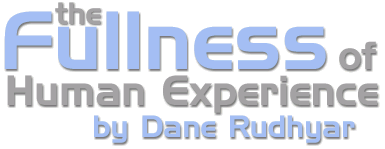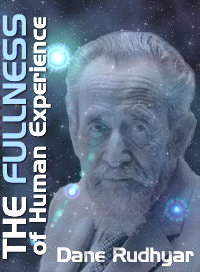 |
| Home | Bio | Art | Music | Literature | Civilization & Culture | Philosophy of Wholeness | Theosophy & Spirituality | Astrology |

CHAPTER THREE
The Cyclic Structure of the Movement of Wholeness - 1 Abstract patterns and experienced symbols When a person's attention is focused upon a repetitive series of common human experiences indicating the working of a cyclic process, three basic approaches are possible: the person may try to live as fully as possible the unfolding, concrete situations as they are being experienced one after the other; the most noticeable events may be given a symbolic character revealing their meaning in terms of the whole process of change; or general principles may be abstracted from the sequence of events, indicating the way the process and all similar ones are structured. The first approach is experiential and mostly personal, requiring an open and holistic response to each event as it is experienced in itself, with a minimum of attention given to its causes and probable consequences. The second or symbolic approach is concerned not only with the events and the experiences they engender, but also with the relation between these events considered as phases of a whole process. Moreover, it is involved with the meaning of the effects of these events in terms of more or less common human needs or desires, and with the possibility of influencing or controlling these effects. This approach stresses the value of interpersonal communication by means of symbols or myths able to transmit information. The knowledge this information is meant to convey refers specifically to the development of a consciousness of processes, and thus of wholes of experience within definable periods of time. The third approach seeks to ascertain the structural character of any cyclic series of developments produced by a basic and recurrent situation. It "ab-stracts" operative principles, not so much from the events and the experiences they elicit as from their sequence and essential character. The character is "essential" in the sense that it has a fundamental relevance to situations which in themselves may greatly differ, if only because they operate at different levels of experience. The situations differ existentially, but the structure of the process relating the situations is understood to be the same. It is invariant, however varied may be the outer, empirically analyzable events it interrelates. Such a structure can only be discovered through the operation of the human mind when a particular level of mental development has been reached, at least by the intellectual vanguard of mankind. Historically speaking, this seems to have occurred during the sixth century B.C, particularly in India with Gautama the Buddha, and in the Greek world. The circular pattern indicating the cyclic sequence of phases of the Movement of Wholeness, first presented in Rhythm of Wholeness and reproduced here with a few changes in terminology, is the product of this abstract approach. It gives a diagrammatical form to the ever-changing but symmetrical relationship between two fundamental principles. Unity and Multiplicity, which in psychological terms may be interpreted as subjectivity and objectivity. These principles alternately wax and wane, producing an oscillatory type of motion. Neither can ever totally overpower the other. At each moment of the cycle — in each phase of the entire Movement of Wholeness — both are active, though the ratio of their power continually changes. When such a balanced and symmetrical process is considered, four especially characteristic phases stand out. Two of them represent the maximum of power of each principle; and in two others, the principles of Unity and Multiplicity are of equal strength. Abstract meanings which have universal applications can be deduced from the balance of forces which any one phase of the cycle represents. Yet one has to be careful not to identify concrete events with the state of relation to which they refer in the abstract diagrams. When I use concretely observable planetary events such as sunrise, noon, sunset, and midnight as symbols to communicate the meaning of the most characteristic phases of a cycle of experiences shared in general by all human beings on our planet, the approach is mytho-poetic. A series of common experiences is made into a myth. The two interacting and moving factors are no longer such abstract principles as Unity and Multiplicity; they have taken a concrete existential reality — one might say as light and darkness, or radiance and material opacity. Both approaches can be combined, and the abstract pattern may always be considered as having validity at a "higher mental" or archetypal level. In this book (and even if less obviously, in Rhythm of Wholeness), I am dealing with human experiences. I am approaching these basic and common experiences, and the essential meanings they can reveal, by interpreting the abstract diagram reprinted here in terms of the largest cycle I am able to conceive in which humanity can be given a definable, workable, and future-oriented meaning. Archetypally speaking, MAN performs a very important function in this cycle, half of which refers to our universe as we perceive it, and the other half to a realm of predominantly subjective being. This mostly subjective half-cycle in which activity is increasingly dominated by the trend toward Unity, is as "real" to the wholes of being (Pleromas) operating during it as our physical and objective universe is to present-day human persons. It is experienceably real, according to the philosophy of Operative Wholeness, because there is no justification for the traditional, absolute opposition between "being" and "non-being," or between the "manifested" and the "unmanifested" aspects of Brahman. The philosophy I present is, as stated in the subtitle of Rhythm of Wholeness, "a total affirmation of being." Predominantly subjective being is as real as the condition of predominantly objective being on which mankind is now focusing its collective attention. This attention is now focused on objective being because the human mind is so directed by desires which can only be satisfied in terms of what it calls "matter." Ancient Hindu psychologists tried to interpret the relation between predominantly objective and subjective modes of experiencing in terms of the common daily human experience of waking consciousness and states of sleep. Four states of consciousness were defined: waking consciousness, dreams still dominated by external events, deep dreamless sleep, and a synthesizing fourth state, turiya. It was said that in this last state, subjectivity and objectivity were integrated in a way that most people were not able to experience. I might speak of such a state as the experience of Wholeness — an experience which nevertheless inevitably takes different forms at different levels of being.(1) 
The long period during which humanity evolves from a primitive, strictly biological and "natural" state to that of spiritually "Illumined Man" constitutes the predominantly objective series of phases, which are given a mythical interpretation in terms of the daily cycle of human consciousness on this rotating planet. This is the stage of "waking consciousness." Mankind, in both an individual and a collective sense, has a function to perform. As we shall see in a later chapter, this function can be more significantly understood when interpreted in terms of a relatively new frame of reference, the Earth-being, in whose planetary field of activity all human beings participate. Beyond this strictly human and predominantly objective level of reality requiring a body of opaque, light-obscuring physical matter, other levels of being have to be assumed if the whole cycle of being is accepted as the necessary frame of reference. The superhuman planetary state of being operates in terms of Pleromas of being, whose character and function in the great cycle will soon be discussed. These Pleromas are also "evolving" toward as complete a realization of Unity as possible. They evolve through what is symbolically the deep dreamless state of sleep which leads to the condition of maximum Unity, the Godhead state. This state, of course, has to be considered beyond what human beings mean by the term "personality" or "personhood." Yet because in such a condition of being, as well as in any other. Wholeness must include the operation of both fundamental principles. Unity and Multiplicity, an experience of the Oneness which would absolutely exclude the drive toward Multiplicity is impossible. In the Godhead, a tremendous surge of Compassion arises which, as we shall see, takes the ideal form of a new universe which will provide a "second chance" for the failures of the past universe to experience Wholeness in a fully re- awakened state. A new cycle thus begins at the symbolic Midnight hour with the Godhead's vision of what is needed to offset and neutralize the negative memory-remains and waste-products of the old cycle. The envisioned ideal gradually assumes complex archetypal forms, and a moment comes (the symbolic Sunrise) when a tremendous surge of "creative" power arises out of the undefinable immensity of Space — a surge which theologians have interpreted as the Creative Act (or Word) of a God. The Creator may be considered to be one single God, but in that case the existence of this God refers to a unitarian release of cosmogenetic energy. This energy, which we may assume to have a spiral-like character, is soon given a stabilized form; it becomes the potential power inherent in the relatively few material elements to which the chemist gives specific names. As planets are formed and masses of solid matter react to an immense variety of influences and radiations, "life" begins to appear on the surface of those planets which provide favorable conditions for its development. Symbolically, life manifests during the second half of the period between the Sunrise and Noon period of the great cycle. At Noon a sudden reversal of the cosmic motion occurs. The principle of Multiplicity having reached the maximum of its power, the principle of Unity once more reasserts itself. A momentous event takes place to which I shall refer as the appearance of the Supreme Person, in whom the cosmogenetic vision of the Godhead finds itself fully objectivized. Then the period of human evolution and the development of "personhood" begins. These various phases of the Movement of Wholeness, mentioned here in a most condensed form, have been outlined in greater detail in Part Two of Rhythm of Wholeness; they will be further analyzed and interpreted in the following chapters Five and Six. Before this can be done in a truly significant manner, a few basic points should be discussed concerning some aspects of the cyclic concept which need special elucidation. The first concept to be clarified is that of symmetry, as the use I have made of the term symmetrical can easily lead to some misunderstanding. 1. The terms Wholeness and Beness are used almost interchangeably in my works. Every whole is an entity in and through which Wholeness may be realized and experienced. Similarly, every being is a particular manifestation of Beness, a manifestation whose nature and function can be defined in terms of the particular balance of power of the principles of Unity and Multiplicity at that particular point of the Movement of Wholeness. Wholeness is the ever-changing cyclic state of relatedness of Unity to Multiplicity. Return By permission of Leyla Rudhyar Hill Copyright © 1986 by Leyla Rudhyar Hill All Rights Reserved.  Web design and all data, text and graphics appearing on this site are protected by US and International Copyright and are not to be reproduced, distributed, circulated, offered for sale, or given away, in any form, by any means, electronic or conventional. See Notices for full copyright statement and conditions of use. Web design copyright © 2000-2004 by Michael R. Meyer. All Rights Reserved. |
 |
